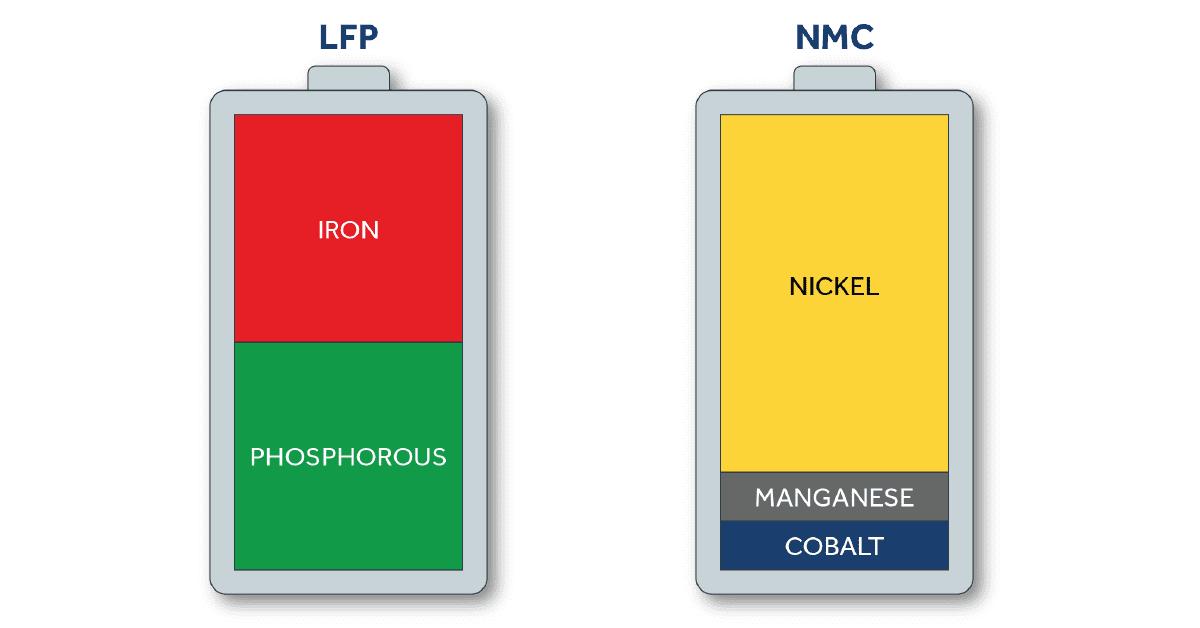
Technical Article
Comparing NMC and LFP Lithium-Ion Batteries for C&I Applications
The emerging energy storage industry can be overwhelming, but it is also exciting, with significant opportunities for impact. Energy storage is increasingly adopted to optimize energy usage, reduce costs, and lower carbon footprint. Among the various lithium-ion battery chemistries available, Nickel Manganese Cobalt (NMC) and Lithium Iron Phosphate (LiFePO4, or LFP for short) have emerged as popular choices for large-scale stationary energy storage applications. The strengths and drawbacks of each battery chemistry are important to align your product selection with the performance requirements of your overall system.
Understanding Battery Chemistry

In a previous article, we discussed how a lithium-ion battery works and provided an introduction to NMC and LFP batteries. Let’s dive into the details further.
NMC Battery Composition
NMC batteries are a type of lithium-ion battery with a cathode composed of nickel, manganese, and cobalt. Nickel is the primary source of energy storage with high specific energy, but it needs manganese and cobalt to stabilize and provide the desired power output. These batteries are comprised of a ratio of material of 8:1:1 (8 parts nickel, 1 part manganese, 1 part cobalt) to minimize the use of Cobalt, which is expensive and difficult to procure. NMC batteries are all around us and are most commonly used in smartphones, laptops, and electric vehicles.
LFP Battery Composition
LFP batteries are another variant of lithium-ion batteries that employ roughly equal amounts of iron and phosphate within the cathode. The materials that makeup LFP batteries are more abundant, cheaper, and less toxic (so easier to recycle) than those in NMC. LFP batteries are commonly used in stationary energy storage and are under consideration for other markets as well, such as electric vehicles.


Comparing NMC vs. LFP
Now that we have outlined the basics of each battery chemistry, let’s compare their performance and use case for stationary energy storage systems in the commercial and industrial (C&I) sectors.


Energy Density
The energy density and size of individual cells and integrated packs are important considerations that drive the cost of equipment. Larger packs need more material to contain them, and in project development, more space increases land costs. The specific energy of LFP, ranging from 90 to 120 Wh/kg, is less than that of NMC (150 to 220 Wh/kg).
However, that is not the full story. While the individual NMC cells have higher energy density, the higher safety of LFP means the cells can be packed more tightly together. Therefore the total size of an integrated pack is not as different as the cell density may suggest, as represented in the chart below.

Safety
Safety is of paramount importance for energy storage systems. LFP batteries excel in this area, offering a higher level of safety and thermal stability than NMC batteries. The inherently stable chemistry of the iron phosphate cathode structure provides LFP batteries with enhanced resistance to thermal runaway, overheating, and fires, which are critical safety concerns in C&I applications. LFP batteries' higher safety and ability to handle more stress and abuse are primary benefits of the technology.
Performance
Overall, performance is comparable between NMC and LFP batteries for energy storage applications. NMC batteries tend to have slightly higher power densities, allowing them to discharge and charge at higher rates compared to LFP batteries. While this is valuable for certain applications, the specific power capabilities of LFP are sufficient for stationary energy storage applications.
Cycle Life
LFP batteries present a compelling advantage for stationary energy storage systems for C&I systems where long-term reliability and durability are paramount. NMC batteries can achieve 1000 - 2000 charge-discharge cycles, while LFP batteries typically deliver 3,000 cycles or more. The higher cycle life means that LFP batteries will last longer, leading to reduced operational costs over the battery's lifespan.
Cost
Cost considerations play a crucial role in evaluating the feasibility of energy storage projects. As discussed in our recent post on the Inflation Reduction Act, project selection and execution are largely driven by the expected return on investment on project costs. Currently, due to their extensive use in electric vehicles, NMC batteries have a stronger supply chain and lower capital cost than LFP batteries. This discrepancy is anticipated to come down with continued growth in the LFP demand. It is also important to not only consider the upfront investment but also the levelized cost of electricity (LCOE) over the battery system's lifetime. With significantly longer cycle life, LFP batteries have better long-term financial viability, as suggested by the PNNL table below. A further breakdown of project costs using LFP batteries is available from NREL.

Conclusion
Nickel Manganese Cobalt (NMC) and Lithium Iron Phosphate (LFP) both fall under the “lithium-ion” battery category, but differ based on a number of important factors. While NMC batteries boast higher energy density and specific power—making them suitable for space-constrained applications with high power demands—LFP batteries excel in safety, thermal stability, and cycle life, making them ideal for stationary energy storage projects where safety and long-term reliability are paramount.
For most C&I facilities seeking to implement stationary energy storage systems, the LFP advantages make it the most likely the best choice for your project. This is reflected in the increased use of LFP in many battery manufacturers and why LFP batteries are expected to lead the stationary storage market by 2030. While we addressed the key items, there are further differentiators that we didn’t get into here.
Mayfield Renewables can help your team identify the best products for your portfolio with our System Architecting and consulting services. Reach out to learn more.


